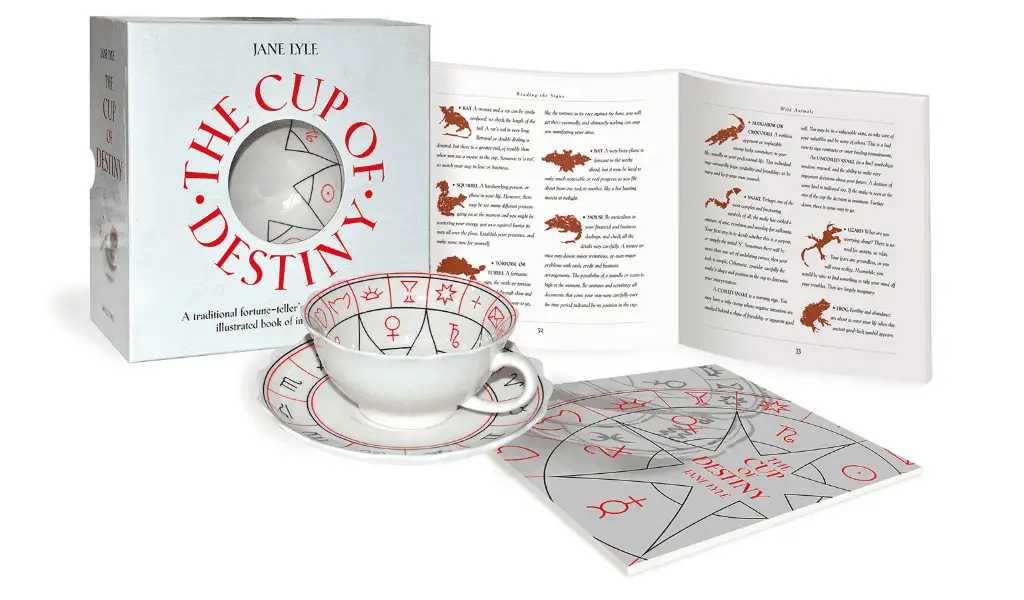
Picture yourself, cozy on a rainy day, sipping a hot cup of tea. As you reach the end of your cup, you notice a unique pattern in the tea leaves at the bottom. What if I told you that these seemingly random patterns hold the key to unlocking hidden messages and insights? Welcome to the world of tasseography, a mystical art form that many are eager to explore.
Tasseography is the art of reading tea leaves to interpret symbols and patterns for divination. It has origins in Chinese, Greek, and Middle Eastern cultures and can also be applied to coffee grounds or wine sediments. Many believe it reveals one’s future, relationships, and personal growth.
If you’re seeking a new hobby that combines history, mysticism, and a touch of intrigue, then tasseography is perfect for you. Not only does it offer an opportunity to connect with your intuition, but it also allows you to tap into a rich cultural heritage. So grab your favorite teacup, and let’s go on a journey to unravel the secrets of tasseography together.

THE ART OF TASSEOGRAPHY
Tasseography is a fascinating form of divination that goes beyond merely interpreting tea leaves, coffee grounds, or even wine sediments. It delves into the realm of intuition, symbolism, and our subconscious mind, offering a unique perspective on our lives and futures.
Tasseography falls under the umbrella term divination alongside osteomancy, tarot cards and readings, rune stones, numerology, pendulum readings, and more. Central to the art of tasseography is the role of intuition. As a reader sifts through the patterns left behind by the tea leaves, they rely on their innate ability to discern meaning from the seemingly random shapes and formations. This intuitive process allows for a deeper understanding of the symbols and their potential significance in the querent’s life.
Symbolism and imagery act as the lynchpins to this form of divination, as the tea leaves patterns form recognizable shapes that can be linked to various aspects of life.
For example, imagine the tea leaves forming a shape similar to a heart, this might be a representation of romance and love, whereas seeing a bird could signify freedom or travel.
This is all up to the reader’s interpretation, which is why it’s important to have a firm grasp of the symbols and what they mean. Those who excel in the art of tasseography have a strong connection to the subconscious, allowing them to interpret patterns and symbols by unearthing hidden thoughts, desires, and fears.
If it all sounds a bit fantastical, and that’s because it partly is, but the rationale behind it is this process allows for a more profound insight into the individual’s life, revealing personal truths that may have otherwise remained concealed.

What Is the Meaning of Tasseography?
Tasseography is the art of interpreting tea leaves or other drink remnants to foretell one’s future, and the word is derived from the French word “tasse,” which means “cup,” and the Greek suffix “-graphy,” meaning “writing” or “description.” Directly translated, tasseography is “cup description”.
What Is Tasseomancy?
Tasseomancy is an interchangeable word for tasseography, both referring to drawing insights through the interpretation of tea leaves, coffee, and wine sediment. “Tasseomancy” comes from the French word “tasse” (cup) and the Greek word “manteia” meaning divination.
With the history and language lessons out of the way, let’s have a look at what you need to follow along with the tutorial, and then we’ll jump into the actual lesson.
The Role of the Reader in Tasseography
The tea leaf readers take center stage in tasseography, decoding the cryptic symbols and patterns spun by the leaves. It might sound a bit odd to the unpracticed, but the read has to enter tea leaf reading with a heart of empathy and understanding, this is the only way to decipher the emotions and experiences that will unfold. This is why tasseography is a bit of a dance between intuition and observation, allowing the reader to unveil subtle messages and deliver spot-on interpretations.
WHAT DO YOU CALL SOMEONE WHO READS TEA LEAVES?
A person who reads tea leaves is called a tasseographer. They practice tasseography, a time-honored tradition of interpreting symbols and patterns in tea leaves to reveal insights and predictions.
As a tea leaf reader, approaching each cup with an open mind and one with careful ethical considerations are key to brewing a successful practice. Each session should be approached with respect and sensitivity, mindful of the impact your words may have. Your sessions should be confidential, and avoid predictions that could cause distress or harm. Instead, focus on stirring up guidance and insight that nurtures growth and self-reflection.
Can you read other’s leaves? Yes! But…. your cup is for you and you only. It’s best practice to have a designated tea reading cup for yourself and for your thoughts. When reading other’s leaves, prep as you would for yourself and allow them to sip their tea from their cup and then read the leaves they leave behind.
Brewing a strong bond with your intuition is vital in the mystical realm of tasseography. Strengthen this connection with regular practice, meditation, and mindfulness exercises. Let your instincts be your compass, guiding you through the intricate symbols and patterns in the tea leaves, leading to profound and meaningful readings. As you refine your observational skills, you’ll find yourself spotting even the tiniest details in the tea leaves.

SUPPLIES NEEDED FOR READING TEA LEAVES
At a minimum, you need a teacup, saucer, and tea. But our tutorial is a bit more expansive than that. If you want to follow along to a “T” (we love our puns around here) then grab the following items. We’ll explain their purpose as we go along. If you scroll down a bit too, you’ll find a couple of kits we love. One is nearly identical to the tasseography kit we used to sell.
- Tea Cup, Saucer, and Stir Spoon: Use what you have around if you like. We just think this one is beautiful, and it’s close to what we used in the tutorial below.
- Black Oolong Tea: The type of tea you uses matters – more on that in a minute, but we highly recommend a loose-leaf oolong tea.
- Sage Smudge Sticks: You’ll use this as part of purifying the environment before you engage in reading tea leaves.
- Pocket Guide Book: This tiny book, “Tea Leaf Reading”, packs a big punch – it’s one of the best-selling tasseography books of all time.
Choosing the Right Tea and Teaware
When diving into the world of tasseography, the right tea and teaware have a massive impact on the experience. Let’s start with the tea itself. Nearly every tasseographer prefers loose-leaf tea over bagged tea, as the former allows for more detailed patterns and symbols to form in the cup. Black and green teas more specifically, because their larger leaves make it easier to distinguish symbols.
As for the teaware, while there’s no strict requirement for a special cup, some enthusiasts enjoy using traditional teacups and saucers with a wide, shallow design to easily read the tea leaves. It’s also best to choose a teacup that is light-colored so there is high contrast with the tea leaves, making it easier to read. The choice of the teacup, however, largely depends on personal preference and connection to the art form.
WHAT LEAVES ARE BEST FOR TEA READING?
The best leaves for tea reading are loose, large-leaf varieties like Assam, Darjeeling, and Oolong. These leaves unfurl as they steep, creating distinct patterns in the cup, making them ideal for tasseography interpretations.
DO YOU NEED A SPECIAL CUP TO READ TEA LEAVES?
No, a special cup isn’t necessary for reading tea leaves. However, a cup with a broad brim and light-colored interior can be helpful, as it allows for better visibility and interpretation of the tea leaf patterns. Some specialized cups even offer illustrated guidance inside the cup.
Tasseography Kits We Recommend
Although neither includes sage, there are two kits we really love. The first is a teacup, saucer, and book combination. It’s called the Cup of Destiny, and what’s amazing about it regions for interpretations are etched onto the teacup. So you have your guide built right into the vessel.
The other kit we are obsessed with is a nearly complete tasseography kit – it includes tea, a teaspoon, the exact Tea Leaf Reading book we use, three types of tea, a few inserts for symbol interpretation, and it’s all encased in a gorgeous carved wooden box. The only downside is it doesn’t come with a teacup and saucer. But if you have that already, but lack the rarer items of tasseography, this kit is a great fit.
With all the items out of the way, it’s time to read your fortunes.
THINGS TO NOTE BEFORE YOU START READING TEA LEAVES
To navigate the world of tea leaf reading, understanding the teacup’s layout is essential. Each section of the cup holds specific insights, and using the handle as a point of reference helps you guide interpretation more accurately. Each section has its unique significance, so pay close attention to where the symbols appear.

The Anatomy of a Teacup for Tasseography
Start by dividing the teacup into three sections: the rim, the sides, and the bottom.
- Rim: The rim represents present or immediate future events. Symbols found here may suggest events that are currently unfolding or will take place shortly.
- Side: The sides offer insights into more distant occurrences, with symbols indicating developments that are further away but still within reach.
- Bottom: The bottom, on the other hand, delves into the far future or the deepest aspects of one’s life. These may take time to come to fruitition.
The handle of the teacup serves as the reader’s compass. It often represents the querent (the person for whom the reading is being done). By treating the handle as the starting point, you can explore various directions within the cup. For example, symbols appearing to the left of the handle may indicate the past, while those on the right might reveal future developments.
The biggest takeaway with the teacup is remembering that it’s more than just a vessel for your tea; it’s a wayfinding map for personal growth. The better you know your way around the teacup and tea, the better you’ll be able to interpret the subtleties that lie within.
TIMEFRAMES IN TASSEOGRAPHY
Estimating when events may occur in tasseography isn’t an exact science, it’s an art at the end of the day, but practice and intuition can help you develop a sense of timing. Keep in mind that every reading is unique, and factors such as the tea blend, cup shape, and individual interpretation can influence the outcome.
Embrace the insights you gain from tasseography as guidance, not definitive answers, and enjoy the journey of self-discovery that this ancient practice offers.

Integrating Context and Personalization
One of the keys to mastering tasseography is understanding that each reading is a unique blend of symbols, context, and personal experiences. By factoring in the querent’s (whether it’s you or someone else) situation and adapting the meanings of the tea leaves, you’ll create a more meaningful and personalized interpretation.
When you read tea leaves, your first step should be considering the individual’s background, questions, and concerns. This will help you tailor interpretations in a more valuable way – it adds significance to symbolism.
For example, a bird symbol might represent travel for someone planning a trip, while it could symbolize freedom for someone else contemplating a significant life change. One is rather benign whereas the other is a critical lifestage. Knowing the querent’s situation in depth is the only way to help guide them with the interpretation. Be a guide at their side, not a sage on the stage, which is just a fun way of saying don’t be a know-it-all if you’re reading for someone else. Rather, try to help them work through the reading without defining everything for them.
This includes adapting symbols to the querent’s unique experiences. This is far easier if you’re reading your tea leaves, but if you’re helping someone else out, you’ll need to heavily rely on what you know about them and your intuition. Together, they’ll help you uncover meaningful interpretations. This isn’t an easy task at the start, but as you get more teacups under you, you’ll start to build your skills. Balancing intuition and interpretation is the heart of tasseography. While it’s essential to familiarize yourself with common symbols and their meanings, remember that each reading is an opportunity to explore the querent’s unique story – the last bit of advice here is to trust your instincts.

Common Symbols in Tasseography
There are endless symbols in tasseography – it’s a bit like looking at the clouds and asking people what they see. Every single cloud is unique to the eye of the beholder. However, there are some common shapes that people tend to see, and they’re heavy with symbolism. Your tasseography book will be able to offer amazing guidance on other symbols, but here are a few of the most common ones that people see.
WHAT DOES THE DRAGON IN TEA LEAVES MEAN?
A dragon in tea leaves signifies power, strength, and transformation. It’s a favorable sign hinting the person may undergo significant changes but is in a position to overcome whatever challenge awaits them.
WHAT IS OWL IN TASSEOGRAPHY?
In tasseography, the owl symbolizes wisdom, intuition, and mystery. It’s a fascinating sign, hinting that the individual might hold hidden wisdom or confront situations calling for careful consideration.
WHAT DOES A DOG MEAN IN TEA LEAVES?
In tasseography, the dog represents loyalty, friendship, and protection. As a dependable symbol for a faithful animal, it indicates the individual might enjoy lasting relationships and strong bonds or receive assistance from close connections, such as friends and loved ones.
WHAT DOES AN ELEPHANT MEAN IN TEA LEAVES?
An elephant in tea leaves signifies strength, wisdom, intelligence, and stability. This powerful symbol indicates the person may encounter opportunities for personal growth and acquire valuable insights. In other words, life lessons are coming that this person can process.
WHAT DOES A BUTTERFLY MEAN IN TEA LEAVES?
The butterfly in tea leaf reading symbolizes transition, growth, renewal, and progression. It’s a delicate symbol often suggesting that a person is about to start a long journey of self-discovery but ultimately will reach a more mature state.
Bad Omens in Reading Tea Leaves
For some people, the arts of divination come with some heavy baggage. And those who look into the darker side of the occult may want to know omens that are a bit more foreboding. Here are a couple of those darker symbols that are commonly seen:
WHAT IS THE BAD OMEN IN TEA LEAVES?
In tea leaf reading, a bad omen is often represented by negative symbols like snakes or daggers. These symbols signify obstacles, betrayal, or conflicts, cautioning the reader to be vigilant and prepared for challenges.

HOW TO PRACTICE TASSEOGRAPHY
If you haven’t already begun to read your tasseography pocket guide, we’d highly suggest it before you run through the following steps. The book starts by giving you a brief history of tea leaf reading, what to do before you begin with a step-by-step guide to sipping your tea, and the 3 Sectors of your teacup. And finally a detailed glossary for symbols in tea leaf reading (pages 58 – 32).
With a massive amount of background and research behind us, it’s now the moment you’ve patiently been waiting for – here’s how you to practice the wonderful world of tasseography.

Step 1: Preparation and Setting the Mood
Begin by choosing a quiet and comfortable space in your home or backyard where you can focus and relax. Set the mood by dimming the lights, lighting a candle or two, and playing soft, soothing music in the background. You need a clean, calm, and relaxing environment – so put extra thought into your location.
If you purchased sage smudge sticks, this is the perfect time to use them for purifying your atmosphere. The therapeutic smoke these little bundles emit is conducive to introspection and self-reflection, essential for an authentic tea leaf reading experience.

Sage smudge sticks are typically sourced from one of two types, desert sage, and white sage. Desert sage will have a more purple hue to it, whereas white sage is the color you’d expect with a name like that. Both have been used in many cultures to clear space by bringing protection and cleansing to the space it is burned in. It’s believed that the smoke attaches to negative energies, and as the smoke then begins to dissipate it transforms those negative energies into universal energy.
To do this properly, you’ll want to smoke out any negative energy from your house, this means either moving from the back of your house to an open front door or from your bedroom to the open door of your room. For a more thorough explanation, watch the video above.

Step 2: Brewing the Tea
Select a tea with whole leaves, avoiding any dust or fanning. Place two pinches or teaspoons of loose tea leaves at the bottom of a round or wide-mouthed teacup. Boil water and fill the teacup, allowing the tea to steep for a few minutes.
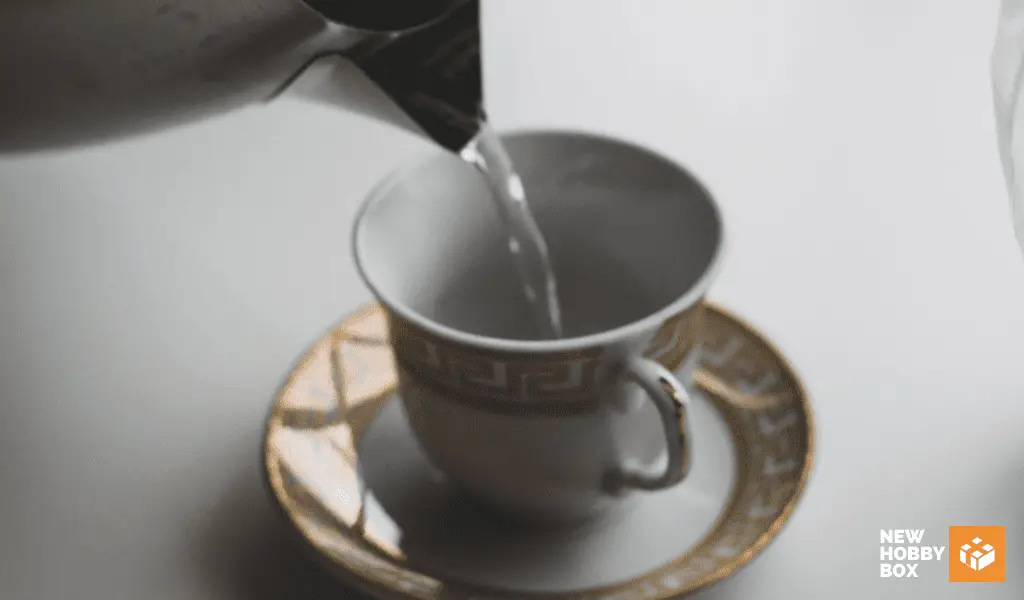
As you pour the tea into the cup, be present and attuned to the process. Observe the leaves swirling and settling, creating intricate patterns that will soon reveal the hidden messages within. By carefully preparing the tea and setting the stage, you establish the foundation for a captivating and enlightening tasseography experience.
The longer it steeps, the stronger the tea will become, and the more prominent the leaves will be for reading. As you wait, use this time to clear your mind and focus on the questions or concerns you have, simply take a moment to focus on your intentions. Close your eyes, breathe deeply, and channel your energy toward the querent’s question or concern. This mindful practice paves the way for a more accurate and insightful reading, as it connects you with your intuition and the querent’s energy.

DO YOU BOIL THE WATER BEFORE ADDING TEA LEAVES?
Yes, boil water before adding tea leaves for tasseography. Heating water to the right temperature enhances the tea’s flavor and ensures optimal steeping. Different tea types require specific temperatures to extract the best aroma and taste.
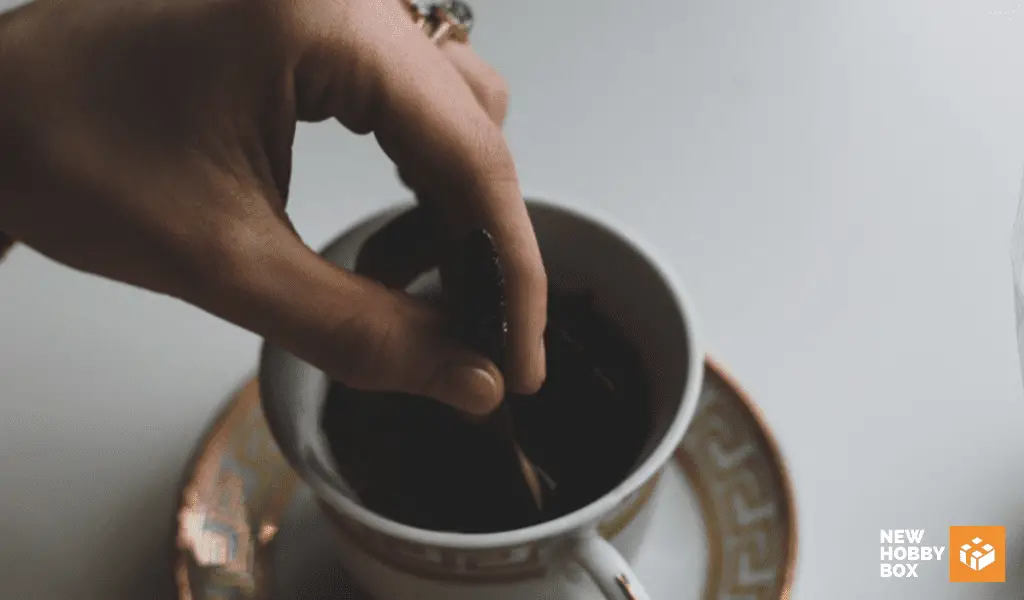
Step 3: Swirling and Sipping the Tea
Once the tea has steeped, gently swirl the contents of the cup three times in a clockwise direction. The key is to find the perfect balance between motion and stillness, allowing the leaves to reveal their secrets without overmanipulating them. This motion helps to create patterns with the tea leaves.
Now, slowly sip and savor the tea, taking in the aroma and flavor. Use this time to continue reflecting on your thoughts and questions.

As you sip the tea, pay close attention to the sensations it evokes – how are you feeling? While drinking, hold the intention of seeking answers in your heart, allowing the tea leaves to reveal their mysterious messages.

Be sure to leave a small amount of liquid at the bottom of the cup to help move the leaves during the next step. The tea’s residue, a tapestry of symbols and images, will serve as your guide during the reading, unveiling hidden truths and enlightening your path.

HOW TO DRINK TEA LIKE A PRO TASSEOGRAPHER
- Loose leaf tea without a diffuser means floaties. Expect to get some leaves in your mouth from time to time.
- Drinking your tea from your non-dominant hand coordinates your left and right brain activity to stimulate creative problem-solving.
- It’s best to only use one method of tasseography at a time. If you choose to focus on a specific question, be sure to allow yourself enough time to slow down and focus on the question and your intentions. In doing this, you’ll help organize your thoughts better.

Step 4: Turning the Cup and Revealing the Leaves
Place a saucer or napkin on top of the teacup, then quickly and confidently turn the cup upside down onto the saucer, allowing the remaining liquid to drain out. Give the cup three complete turns in a clockwise direction, helping to arrange the leaves into patterns. Gently lift the cup and place it on the table.
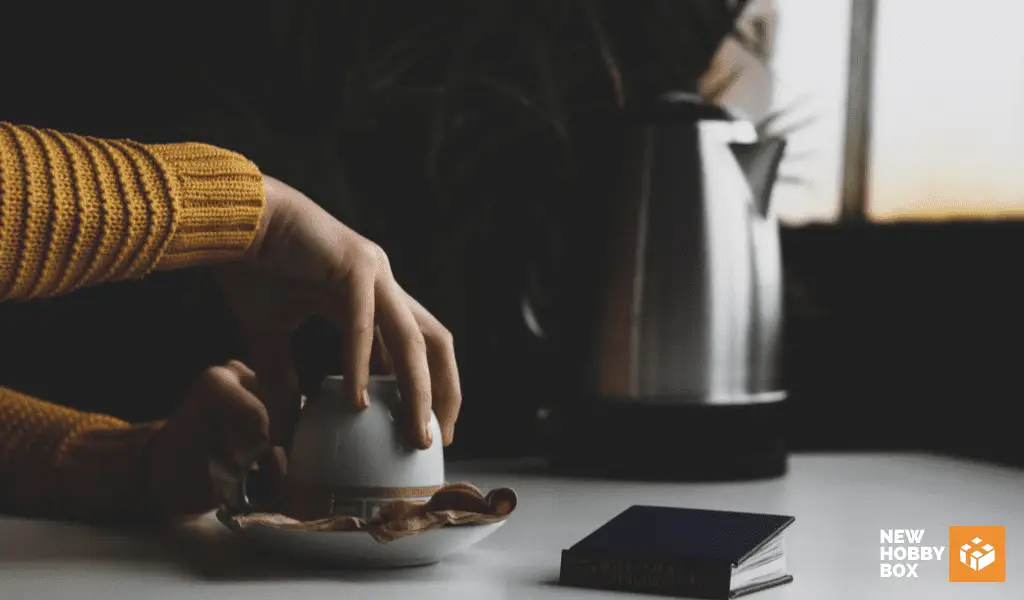
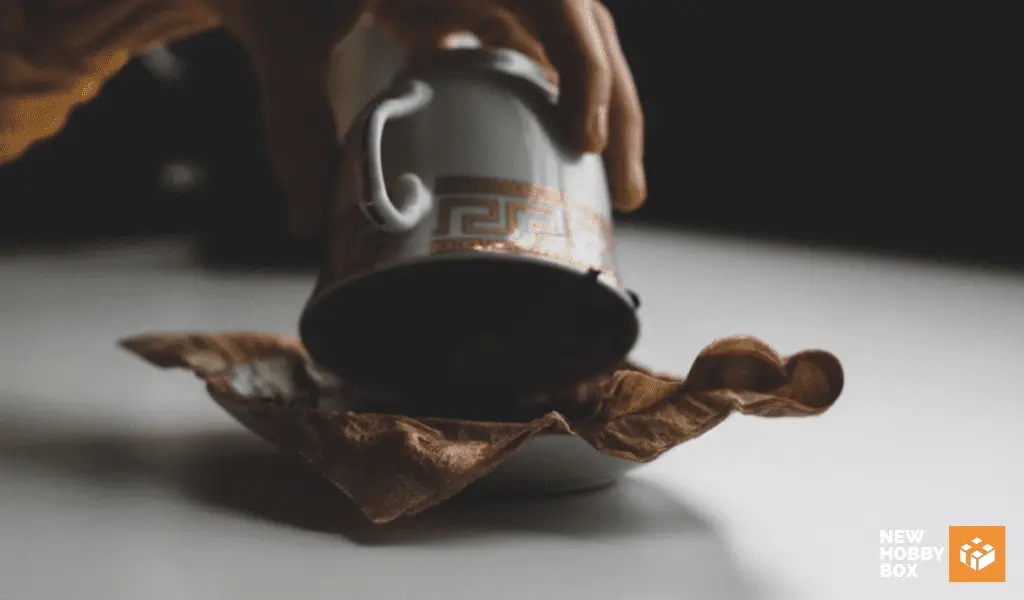
This step requires patience and precision; rushing may disturb the delicate patterns the leaves have created. While inverting, remember that timing and temperature matter – wait until the cup is slightly cooled to prevent scalding but also so the leaves stick to the cup’s surface.

Step 5: Interpreting the Tea Leaves
As you lift the cup, first, take a deep breath and clear your thoughts. Then, observe the intricate designs left behind by the leaves – examine the shapes, symbols, or patterns that stand out. Go with your gut when interpreting the images you see. You may want to refer to a glossary or guidebook to help identify and interpret the symbols if this is your first time reading tea leaves.

As you discover the meanings behind the symbols, reflect on what they mean to you in the context of your life and the questions you had in mind. For instance, a heart may signify love or relationships, while a star could represent hope or aspirations. These meanings are not set in stone, so allow your intuition and personal experiences to enrich your interpretation. Subjectivity is innately connected to tasseography, as each reading is unique to the individual.

Your book will help you understand the symbols in greater detail, but it’s worth noting that some symbols (like the sun) can mean different things depending on what sector of your teacup they appear in. So be sure to stay aware of the location of symbols while you interpret their meanings.
Step 6: Reflecting and Practicing
If your first attempt doesn’t reveal clear or meaningful patterns, don’t be discouraged. Continue to practice and refine your skills, and over time, you’ll become more adept at interpreting the messages within the leaves. Remember to approach each reading with an open mind and a relaxed, focused attitude.
ENHANCING YOUR TASSEOGRAPHY PRACTICE
The world of divination, including tasseography, is deep and storied. That’s good news for you though, since that means there are millions of resources available to you if interested in developing your skills. Simple things like keeping a journal, defining unique symbology, and learning from other practitioners are some of the best ways to excel.
A tea leaf reading journal is a way to document each reading, which helps you track your progress while also revealing patterns and personal symbolism over time. It doesn’t have to be a formal exercise either. You can easily jot down the symbols you encounter, their interpretations, and any feedback from the querent. Journaling of any kind is a great hobby for reflecting, and ultimately sharpening your intuition.
While traditional symbols and meanings provide a foundation, your personal experiences and connections to certain images will give your readings a unique touch. By incorporating your interpretations of symbolism that you create, you’ll build a more authentic and relatable reading experience for your querents.
Lastly, don’t be afraid to learn from other readers. Engaging with the tasseography community, whether online or in person, can provide valuable insights, tips, and inspiration. The subreddit community r/tasseography has amazing discussions over coffee and tea readings. There, you can exchange ideas, discuss interpretations, and observe different reading styles. This is a fantastic way to find your voice as a tea leaf reader and further refine your skills.
Tasseography vs. Other Divination Methods
As you explore the art of tasseography, you might be curious about how it compares to other divination methods, such as Tarot, runes, and the I Ching. Each of these practices offers its unique approach to unveiling insights and guidance.
There’s an amazing book that can guide you through all the different ways to approach divination, it’s called How to Study Magic, by Sarah Lyons. This is easily one of our favorite books about the occult, as it’s actually written for a beginner but also hilariously entertaining. If the idea of divination excites you but reading tea leaves doesn’t as much, head over to Amazon and grab a copy of this book. You’ll get a sneak peek into dozens of different approaches, helping you land on one that you’ll ultimately love.
But in general, here’s how tasseography compares to Tarot, runes, and I Ching – a few of the more popularized forms of magick:
TASSEOGRAPHY VS. TAROT
Tasseography is a more organic and fluid practice compared to Tarot. While Tarot uses structured card spreads and predetermined card meanings, tasseography interprets the random patterns of tea leaves left behind in a cup. This free-form nature allows for greater flexibility and a more personalized reading experience, as the leaves can form countless combinations of symbols and messages.
TASSEOGRAPHY VS. RUNES
Runes, another popular divination tool, are based on ancient Germanic alphabets and imbued with symbolic meanings. When cast or drawn, runes offer insights into one’s life and future through their individual meanings and the relationships between them.
TASSEOGRAPHY VS. I CHING
The I Ching, an ancient Chinese oracle, is yet another method that uses coins or yarrow stalks to generate one of 64 possible hexagrams, each representing a unique concept or situation. Similar to tasseography, both runes and I Ching readings rely on interpreting the patterns and relationships of the chosen symbols.
CAN YOU READ COFFEE GROUNDS?
Yes, coffee grounds can be read for divination, too. This technique, referred to as coffee cup reading, analyzes the shapes and arrangements of the grounds to provide guidance and understanding of an individual’s life.

Resources for Further Exploration in Tasseomancy
A great starting point is to explore the wealth of books on tasseography, such as “Tea Leaf Reading for Beginners” by Caroline Dow or “The Art of Tea Leaf Reading” by Jane Struthers. These two stand above the rest because they’re heavy on technique and how to interpret symbols, which are valuable for anyone new to the practice.
Online courses and workshops are another excellent way to develop your tasseomancy skills. Platforms like Skillshare and YouTube offer a variety of classes that cater to different skill levels and interests. By participating in these courses, you’ll have the opportunity to learn from experienced practitioners, ask questions, and even receive feedback on your readings.
Thanks to all the amenities of modern technology, it’s easier than ever to connect with legitimate tasseographers today.
Figures like Tabitha Dial, a professional tea leaf reader, and author, or Amy Taylor, a renowned tasseomancer with decades of experience, offer valuable insights through their writings, workshops, and social media channels (links to their Instagram accounts above).
Following these experts can help you stay up-to-date on the latest trends and techniques in tasseomancy, as well as provide a supportive community for sharing your own experiences and discoveries.

Sip Your Way to Deeper Insights
Tasseography, the art of reading tea leaves, offers a unique and enchanting gateway into a world of personal reflection and self-discovery. The beauty and complexity of this ancient practice lie in its ability to connect us with our intuition, guiding us on an introspective journey through the symbols and patterns found in our tea cups. That’s a beautiful way to say that, right? But there couldn’t be a more fitting hobby deserving of such a detailed description.
The personal and introspective journey that tasseography offers can be transformative. It’s been that in our lives. As you learn to interpret the symbols in your tea leaves, you’ll gain a deeper understanding of your world, allowing you to tap into your inner wisdom and get more intimately connected to what you need out of life. This is instrumental for a growth mindset.
Whether it’s real or not is beside the point. The value you gain from tasseography is learning how to listen to yourself better.
So go ahead, brew a pot of your favorite tea, and embark on a journey of self-discovery that will surely leave you thirsty for more. Cheers to uncovering the wisdom within, one sip at a time!
Happy Hobbying,

